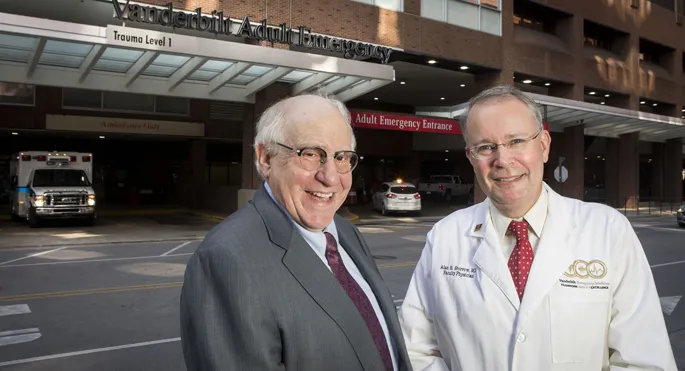Safe Harbors Research Study
Standards of care based on scientific evidence
A safe harbor is a special type of clinical practice guideline that, under existing federal law, may serve as the legal standard of care, not just evidence of the standard of care. Vanderbilt Department of Emergency Medicine is working with partners in the Vanderbilt Law School to develop and test "safe-harbor" standards of care based on scientific evidence.

James Blumstein, LLB, left, and Alan Storrow, MD, are leading the project to develop medical malpractice ‘safe harbors.’
Learn more about Safe Harbors
» Developing Safe Harbors to address malpractice liability and wasteful healthcare spending
With national health care spending in the US expected to top $7.2 trillion by 2031, the push to reduce health care resource utilization will only intensify in the coming years.
One important approach is curbing the expenditure of health care resources on unnecessary tests and procedures.
» Constraints on Medical Liability through malpractice safe harbors
Liability immunity has been an issue, specifically, for medical liability for decades; it reflects concerns about increased healthcare spending because of undue fear of liability, commonly described as defensive medicine.
» Team to develop ‘safe harbor’ standards of care
A team of researchers from Vanderbilt Health and Vanderbilt University’s schools of Law, Medicine and Management has received a five-year $1.7 million research grant from the Agency for Healthcare Research and Quality of the Department of Health and Human Services to develop and test “safe-harbor” standards of care based on scientific evidence.
» Medical Malpractice Standard-Setting: Developing Malpractice "Safe Harbors" as a New Role for QIOs?
Concern about medical malpractice issues has reemerged, again stemming from escalating costs in some geographic regions and sectors of medical practice.
Safe Harbor Protocols
If a patient with the conditions described below satisfies all safe harbor inclusion criteria and does not meet any exclusion criteria, no imaging is required, and the patient may be discharged with specific instructions. If a patient is excluded from the safe harbor, then imaging decisions are per customary practice.
Click on each of the conditions below to download a PDF with specific guidance on each one.
Safe Harbors Research Team
Co-PI, Safe Harbors study
Associate Professor of Emergency Medicine
Associate Director of the Research Division
Co-PI, Safe Harbors study
University Distinguished Professor of Constitutional Law and Health Law & Policy
Director, Vanderbilt Health Policy Center
University Distinguished Professor of Law, Economics, and Management
Co-Director, PhD Program in Law and Economics
Professor of Economics and Strategy, Emeritus
Vanderbilt University Owen Graduate School of Management
Professor of Emergency Medicine
Director, Center for Emergency Care Research and Innovation (CERI)
Quality and Safety Director, Harvard Medical School Center for Primary Care
Associate Director, Brigham and Women’s Center for Patient Safety Research and Practice
